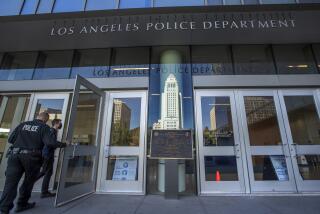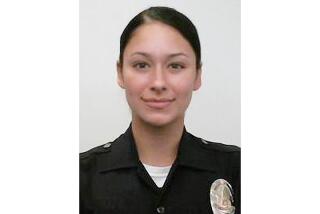Officer in fatal shooting accidentally fires into baby’s crib during routine parole visit
A San Diego police officer who killed a man in a 2015 shooting in the Midway District that is now the subject of a federal civil rights lawsuit accidentally fired his gun into a crib during a probation check in February.
Officer Neal Browder was with other officers on Bayview Heights Place about 8:40 a.m. on Feb. 20 when the shooting happened, said San Diego police Lt. Scott Wahl. He said police conducted an investigation, but he declined to give more details.
Residents at the apartment, located Friday by San Diego Union-Tribune Watchdog, described the accidental shooting.
“If my son had been in that crib, he wouldn’t be here today,” said Kimberly Espinoza, 17, who lives in the apartment with her son, Isaac, then 11 months old, her 54-year-old grandmother, and a 30-year-old uncle who was the subject of the routine probation check.
“And if he was in it, and it had missed my son, he would still be traumatized,” she said.
Join the conversation on Facebook >>
The incident unfolded quickly, the family said.
After the uncle was taken outside the apartment, the rest of the family entered the living room so the bedrooms could be searched by Browder and another officer. Browder and the other officer, guns drawn, entered Espinoza’s bedroom, where the baby’s crib was located.
Suddenly, a shot rang out. According to Espinoza, Browder looked uneasy and nervous and was quickly taken outside while other officers arrived and began investigating.
After several hours, police located the discharged round. The bullet hit the right side of the baby crib, ricocheted left and struck the wall behind it, Espinoza said.
About a week later, another officer returned to collect follow up statements from Espinoza and her family to accompany evidence from the officers’ body cameras, she said. The family asked if the department would help pay for counseling after the event, but never heard back.
They disposed of the crib.
“We threw it away,” she said. “It was a constant reminder of what had happened, and what could have happened.”
The bedroom wall paint is still chipped and the drywall indented where the bullet hit.
Espinoza said she is angry with the officers, who should have been more cautious when entering a home with young children.
Browder, a 28-year department veteran, fatally shot Fridoon Rawshan Nehad in an alley in Midway District on April 30, 2015. The officer was sent to the area after a bookstore employee reported a man had a knife and was threatening people about midnight.
Browder said he shot Nehad after the 42-year-old man refused to drop what the officer thought was a knife. The officer said he believed Nehad was going to stab him. Nehad had no knife, and instead was carrying a metallic pen.
In November, the San Diego County District Attorney’s Officer ruled the shooting was legally justified because Browder believed he faced an “imminent threat” from Nehad.
Two months after the shooting, relatives of Nehad filed a lawsuit in federal court, alleging the shooting violated Nehad’s civil rights, was unjustified and the department’s investigation of officer-involved shootings were flawed and a “whitewash” designed to exonerate officers.
The Nehad shooting was captured on a the security camera of a neighboring business. Police and prosecutors declined to release the footage for months, until a federal court judge lifted a court order in December and allowed lawyers for the family to release the tape and other materials related to the investigation.
The tape shows Nehad walking up an alley and approaching Browder’s parked car, which did not have its emergency lights on. The man appears to slow, but not stop, just before Browder shoots him.
Wahl said Browder was evaluated by a police psychologist during a Critical Incident Stress Debriefing after the fatal shooting, and returned to duty.
Lauryn Schroeder, Lyndsay Winkley and Greg Moran write for the San Diego-Union Tribune.
ALSO
LAPD believes ‘Grim Sleeper’ serial killer never actually slept
‘You want a description of hell?’ OxyContin’s 12-hour problem
Why a historic highway that united California’s two halves may never reopen to cars
More to Read
Sign up for Essential California
The most important California stories and recommendations in your inbox every morning.
You may occasionally receive promotional content from the Los Angeles Times.










